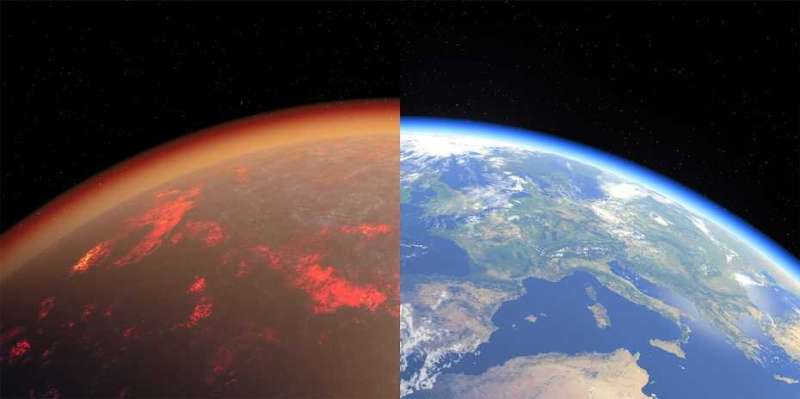For centuries, humans gazed at the stars, marveling at their celestial dance and wondering about their place in the vast cosmos. Earth, our home, seemed to be a steadfast, stable platform, a foundation upon which our lives and civilizations were built. But as scientific curiosity and our understanding of the universe progressed, a profound realization emerged: the Earth, seemingly solid and unyielding, hangs on nothing. This concept, seemingly counterintuitive, is a testament to the mind-bending nature of gravity and the immense scale of our universe.

Image: www.space.com
The journey to understanding Earth’s seemingly unsupported existence wasn’t a linear path. It involved a mix of groundbreaking observations, challenging theories, and the courage of scientists who dared to question the prevailing wisdom. To truly understand how this discovery unfolded, we need to delve into the historical context, explore the key figures who shaped our understanding, and examine the scientific principles that govern our planet’s existence.
Early Theories of the Earth’s Structure
The ancient Greeks, renowned for their intellectual prowess, developed the first comprehensive theories about the Earth’s structure. Philosophers like Aristotle proposed a geocentric model, envisioning Earth as the center of the universe, with celestial bodies orbiting around it. This model, though ultimately incorrect, persisted for centuries, influencing our perception of Earth’s place in the cosmos.
During the Renaissance, a paradigm shift began to take hold. Polish astronomer Nicolaus Copernicus, building upon the works of earlier scholars, dared to challenge the geocentric model. He proposed a heliocentric model, placing the Sun at the center of the solar system, with Earth and other planets orbiting it. Copernicus’s theory initially faced resistance but gradually gained acceptance, paving the way for a revolutionary understanding of the solar system.
Newton’s Law of Universal Gravitation: The Key to Understanding Earth’s Suspension
A pivotal moment in understanding Earth’s suspension came with the work of Sir Isaac Newton, an English physicist and mathematician, in the 17th century. His groundbreaking work, *Philosophiæ Naturalis Principia Mathematica*, laid the foundation for modern physics, and within it, he presented the law of universal gravitation. This law states that every particle in the universe attracts every other particle with a force that is directly proportional to the product of their masses and inversely proportional to the square of the distance between their centers.
This seemingly abstract mathematical formulation held profound implications for understanding Earth’s existence. Newton’s law explained why objects fall to the ground, why the Moon orbits Earth, and why the Earth orbits the Sun. It revealed the unseen force, gravity, that governs the movement of celestial bodies and holds them in their respective orbits.
Exploring the Concept of “Hanging on Nothing”
The concept of Earth “hanging on nothing” might seem paradoxical at first glance. We are so accustomed to the solidity of the ground beneath our feet, it’s challenging to grasp the idea that Earth is suspended in space without any visible support. However, it’s crucial to understand that “nothing” in this context is not a void or emptiness. It refers to the absence of traditional physical supports such as pillars or ropes.
Earth is held in its orbit around the Sun by the force of gravity. This force, though invisible, acts like an invisible tether, pulling Earth towards the Sun, preventing it from flying off into space. Similarly, the Moon, held in orbit around Earth, is also governed by gravity. It’s the same force that causes objects to fall toward the ground, only acting over longer distances.

Image: hisshadowings.com
Implications of Earth’s Suspension: A Deeper Understanding of the Universe
The discovery that Earth hangs on nothing had far-reaching implications for our understanding of the universe. It shifted our perspective from a geocentric view, where Earth was the center of everything, to a heliocentric view, placing Earth in its rightful place as a planet in a vast solar system. It also ushered in a new era of scientific inquiry, prompting us to ask even more profound questions about the universe and our place within it.
The concept of Earth’s suspension also highlighted the power of unseen forces, proving that gravity, though invisible, exerts a profound influence on the cosmos. It demonstrated that our existence is not determined by physical supports but by the delicate balance of fundamental forces, shaping the structure of our universe.
A Timeless Lesson: Embracing Curiosity and Challenging Conventional Wisdom
The story of how scientists discovered Earth’s suspension is a testament to the power of curiosity and the importance of challenging conventional wisdom. It reminds us that the universe is a place of awe-inspiring wonders, often concealed from our immediate perception. Through constant exploration, critical thinking, and a willingness to embrace new ideas, we continue to unravel the mysteries of the cosmos, shedding light on our own place within this vast universe.
When Did Scientist Discover The Earth Hangs On Nothing
Conclusion
The realization that Earth hangs on nothing, held in its place by the invisible force of gravity, represents a profound shift in our understanding of the universe. It is a captivating reminder that our planet, seemingly solid and stable, is suspended in the vast expanse of space, governed by the laws of physics, a testament to the immense power of unseen forces. This discovery underscores the boundless nature of scientific inquiry, encouraging us to continually question, explore, and push the boundaries of our knowledge, seeking to unravel the mysteries that lie beyond our immediate perception.






